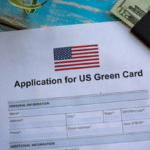You’ve probably stared at visa application forms, wondering which box to tick in the categories and types of visa section. Well, the right choice can make or break your travel, study, or work plans. Whether you’re dreaming of a quick holiday, chasing new job opportunities, reuniting with family, or seeking long-term settlement, finding the visa that matches your story is the key to turning plans into reality.
Stick around, because this article highlights all the different categories and types of visas. At the end of this post, you’ll know exactly which path to take and how to avoid the dead ends that trip up so many applicants.
READ ALSO: How to Apply for USA Green Card, Steps And Requirements
Different Categories and Types of Visas
1. Nonimmigrant Visa Categories
Visitor Visas (Tourism & Business)
- U.S. B-1/B-2 visas permit business or pleasure visits for up to six months per trip.
- UK Standard Visitor visas allow stays up to six months for tourism, business meetings, and short courses under six months.
- Schengen C-Type short-stay visas cover 90 days in any 180-day period across 26 European countries; clear hotel bookings and travel plans help reduce the 16% refusal rate seen in 2023.
Student Visas
- U.S. F-1 visas authorize full-time academic study, on-campus work, and Optional Practical Training post-graduation.
- UK Tier 4 (Student) permits degree courses and includes a Graduate Route allowing up to two years’ post-study work.
- Australian Subclass 500 covers full-time study with up to 40 work hours per fortnight during term.
READ ALSO: Difference Between Permanent Residence and Citizenship
Work & Professional Exchange Visas
- U.S. H-1B visas serve specialty occupations with a cap of 85,000 new visas annually; approval hovers around 70%, but demand far outstrips supply.
- U.S. L-1 visas transfer managers (L-1A) or specialized knowledge workers (L-1B) within multinational companies.
- U.S. O-1 visas target individuals with extraordinary ability in sciences, arts, education, or athletics.
- UK Skilled Worker visas (formerly Tier 2) require a Certificate of Sponsorship, minimum salary, and English proficiency.
- Australia Subclass 482 and 189 visas address skilled labor shortages through employer sponsorship or points-based selection.
Exchange, Transit, and Special Categories
- J-1 Exchange Visitor visas support educational and cultural programs, with categories for interns, trainees, and au pairs.
- C-1/D Transit visas cover short stays in transit for airline and ship crew members.
- A/G Diplomatic & Official visas admit government officials and their staff on official business.
- R-1 Religious Worker visas allow temporary work for religious organizations.

2. Immigrant Visa Categories
Family-Sponsored Immigration
- U.S. Immediate Relative (IR) visas for spouses, minor children, and parents of U.S. citizens have no annual cap.
- Family Preference (F) visas cover adult children and siblings of U.S. citizens under annual limits.
- Canada Family Class quotas aim for roughly 108,000 admissions in 2025 for spouses, children, parents, and grandparents.
- Australia Partner Visa (820/801) follows a provisional/permanent two-stage process for de facto and married partners.
Employment-Based Immigration
- U.S. EB-1 to EB-5 categories range from priority workers and advanced degree professionals to investors committing $1 million–$1.8 million.
- Canada Express Entry manages skilled immigration via a points-based ranking system, plus Provincial Nominee streams.
- UK Global Talent and Skilled Worker visas expedite high-skilled individuals into key sectors.
- Australia Skilled Independent (189) invites top points-scorers without sponsorship via monthly rounds.
READ ALSO: 45 Visa Free Countries Nigerians Can Travel To In 2024
Investor & Special Immigrant Visas
- U.S. E-5 Immigrant Investor visas require $1.05 million (or $800 000 in targeted employment areas) in qualifying investments.
- U.S. E-2 Treaty Investor nonimmigrant visas suit nationals of treaty countries making substantial investments.
- Canada Start-Up Visa targets entrepreneurs with innovation potential supported by designated organizations.
Diversity & Humanitarian Programs
- U.S. Diversity Visa (DV) Lottery allocates 55,000 visas annually to underrepresented countries; Nigerians typically receive about 3,000 slots.
- Refugee & Asylee visas protect those fleeing persecution via UNHCR referrals or affirmative claims.
- Humanitarian Visas in Canada and Australia accommodate special circumstances—victims of crime, human trafficking, or extreme hardship.
How to Choose the Right Visa
- Clarify Your Purpose: Match tourism to visitor visas, studies to student visas, and work to the correct skilled category.
- Check Eligibility & Caps: Review official sites for criteria (e.g., salary thresholds, sponsorship requirements, points) and annual limits.
- Assess Processing Times: Family-preference U.S. visas may have multi-year backlogs, while student and visitor visas process in weeks or months.
- Plan Transition Paths: Explore options like U.S. F-1 to H-1B to EB-2, or Canada’s study-permit to PR routes under Express Entry.
- Consult Accredited Experts: Complex cases—petitions, waivers, investor streams—benefit from legal or certified advisor support.
READ ALSO: Common Reasons for Visa Rejection, and How to Avoid them
Conclusion
Choosing the right visa category, whether a short-term visitor visa or a long-term EB-2 petition starts with understanding each type’s purpose, requirements, and country-specific nuances. Nigerians and other applicants can improve success rates by aligning their goals with the correct visa stream, gathering precise documentation, and preparing carefully for every step.
Before you apply, pinpoint your exact purpose, check official government sources for the latest forms and fees, and gather every supporting document—from bank statements and employment letters to acceptance letters and sponsorship affidavits—to present a clear, compelling case. Pay attention to annual quotas and processing times (for example, U.S. employment-based EB visas or Canada’s Express Entry have fixed caps and rounds) so you can plan ahead and avoid unnecessary delays. And remember: rules can change, always verify requirements on the embassy or immigration website of your destination country before applying.
Have you navigated these visa waters yourself? Maybe you found the perfect student route in Canada or overcame a tricky interview question at the U.S. consulate. Share your stories, tips, or questions below, your insights could make all the difference for someone plotting their own journey abroad.






